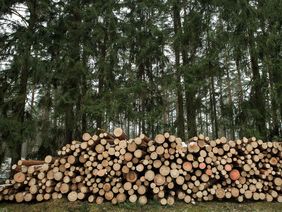Arbor Day: Calculating the carbon footprint of wood correctly


If wood is removed from the forest and used for the production of wood products, construction materials or paper, a carbon footprint is created because less carbon is stored in the forest than if the trees had not been felled. This means that correspondingly less CO2 is removed from the atmosphere. This carbon footprint must be included in the overall calculation of a greenhouse gas balance in order to truly take into account all the climate impacts of wood use.
The Oeko-Institut therefore proposes a new calculation method: the carbon storage balance. This indicates a kind of "carbon backpack" that every harvested cubic metre of wood carries with it, i.e. the amount of carbon the forest would have stored had this cubic metre of timber not been removed. In Germany, the carbon storage balance amounts to approximately 600 to 1,700 kilograms of CO2 per harvested cubic metre of wood.
"A forest from which less wood is harvested could store more CO2 than is sequestered in its wood products, some of which are used only for brief periods," summarises Dr Hannes Böttcher, climate change mitigation and forest management expert at the Oeko-Institut. "So far, however, carbon footprinting of wood has completely ignored these effects; our carbon storage balance closes the gap here."
"Carbon backpacks" differ between the types of wood used
The "carbon backpack" differs depending on the type of forest and the form of wood extraction. If living trees are harvested directly from a young, healthy forest, the effect is greater than if the wood comes from damaged forests or if residual forest wood is taken that accumulated during harvesting. For wood that has already left the forest, such as sawmill residues or post-use wood waste, no carbon footprint needs to be taken into account at all, as the use of these types of wood no longer has a direct effect on the forest.
Ultimately, the decisive factor for the overall balance is how long CO2 remains stored in the product and the degree to which it can displace other, more energy-intensive products that would generate more CO2 (substitution). In the case of a wooden structural element for building construction, for example, the carbon is stored for decades. In contrast, carbon is stored only very briefly in the case of paper and not at all in the case of wood used for heating.
Storage in wood products and substitution effects can even out the carbon storage balance if they are long-lasting and help avoid significant quantities of fossil fuel-derived carbon dioxide. This is by no means the case for all wood uses: for example, the use of roundwood timber for fire logs does not achieve any greenhouse gas reductions compared to fossil fuels when the carbon storage balance is included in the calculation. In contrast, tree trunks can also be turned into durable structural timber for building construction. This replaces fossil fuel-derived or mineral construction materials and thus reduces greenhouse gas emissions by up to 76 per cent.
The CO2-speichersaldo.de/en website summarises the state of research on the carbon storage balance, discloses the data behind the calculations, answers background questions and presents sample calculations.
Forest sink capacity for climate change mitigation
Germany aims to become carbon-neutral by 2045 – forests play an important role in achieving this. Forests are key carbon pools and contribute significantly to reducing atmospheric greenhouse gases. This carbon sink capacity of the forest increases with decreasing forest management intensity, i.e. the sink capacity is greater the less timber is extracted.
Moreover, near-natural forests contribute to biodiversity conservation and are important for our well-being. Wood is a renewable resource that can be used to replace carbon-intensive materials such as steel or concrete, as well as carbon-intensive energy sources such as coal and natural gas. Due to the war in Ukraine, a phase-out of natural gas consumption is becoming increasingly urgent. Consequently, there will also be growing pressure on wood resources which could replace natural gas in heat generation, for example.
The carbon storage balance can help determine the extent to which wood raw materials could be suitable for material and energy uses without placing too great a burden on the atmosphere and the forest carbon sink. Above all, the method can identify which materials serve this purpose. This paves the way for targeted actions such as the promotion of certain wood products that are particularly suitable for carbon storage and fossil fuel emissions reductions, while at the same time being considerate of the forest carbon sink.
For more information please refer to the Oeko-Institut website on "CO₂ Storage Balance - Making CO₂ emissions of wood use visible".
Contacts at the Öko-Institut
Dr. Hannes Böttcher
Senior Researcher
Energy & Climate
Office Berlin
Phone: +49 30 405085-389
Fax: +49 30 405085-388
E-Mail: h.boettcher@oeko.de
Dr. Klaus Hennenberg
Senior Researcher
Energy & Climate
Office Darmstadt
Phone: +49 6151 8191-177
Fax: +49 6151 8191-133
E-Mail: k.hennenberg@oeko.de
